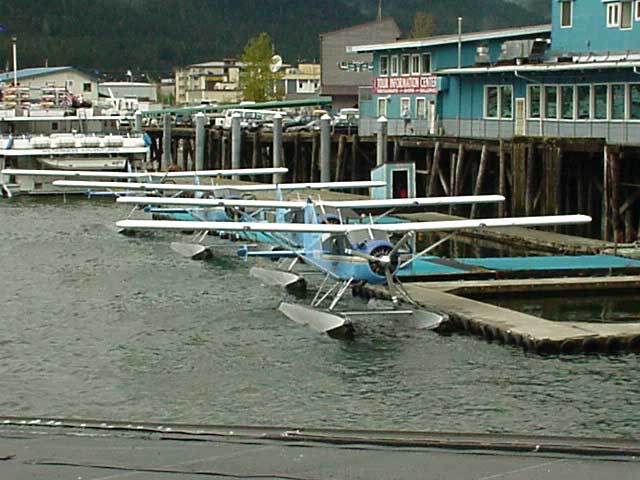|
traumatic
occupational injury
|
|
Commercial Aviation in Alaska |
|
A disproportionate number of all U.S. aircraft crashes occur in Alaska. Between 1990-1999 there were 915 commuter and air taxi crashes in the U.S. (comprising the 50 states and District of Columbia) of which 234 (26%) were fatal, resulting in 708 deaths. Alaska accounted for 357 (39%) of the total U.S. crashes, 55 of which were fatal (24% of the U.S. fatal crashes), resulting in 149 deaths (21% of all U.S. deaths). Alaska’s aircraft crash rate (crashes per 100,000 flight hours) for air taxi and general aviation during 1992-1994 was 2.5 times higher than the U.S. average. Why is the commercial aviation fatality rate so high in Alaska? In part, it's due to Alaska's dependence on aviation to move people and goods throughout the state. Even though Alaska is very large, it has only 12,200 miles of public roads, approximately the same mileage as Vermont, a state with less than 2% of the land area of Alaska. Furthermore, 90% of Alaska’s communities are not connected to a highway system. Even if a road is in place, it may not go any farther than the edge of town or may be an ice road (frozen river or stream) that is only usable during winter. Because of this, commuter and air taxi flights must often serve in lieu of a traditional road system. This makes aircraft essential for personal and commercial transportation of passengers, cargo, and mail to outlying communities. Between 1990-1999, aviation crashes in Alaska caused 106 civilian occupational pilot deaths. This is equivalent to 410/100,000 pilots/year, approximately 100 times the mortality rate for all U.S. workers. During the 1990s there were a total of 1,684 general and commercial aircraft crashes in Alaska, equivalent to a crash every 2 days. Of these crashes, 188 were fatal and resulted in 402 deaths. On average there were 19 fatal crashes per year with 2 fatalities per crash and 40 fatalities per year, equivalent to a fatality every 9 days. The high fatality rate associated with commercial aviation in Alaska has extended in the past to occupations associated with helicopter logging in the state. However, in this industry, a comprehensive approach to safety has demonstrated remarkable success. Crashes in the helicopter industry killed nine Alaska workers, including pilots, co-pilots, and loggers, and seriously injured 10 others during 1992-1993. Interagency efforts led to improvements in regulatory oversight, helicopter logging safety workshops, and in 1994, an international helicopter logging safety committee was formed. Since then, Alaska has only experienced two additional helicopter logging-related fatalities, through 2002. These efforts have lead to major national and international government-industry collaborative efforts to improve safety in helicopter logging operations. The successes in improving safety in helicopter logging operations demonstrate that collaborative efforts can be very effective.
|
Published Reports on Commercial Aviation SafetySurveillance and Prevention of Occupational Injuries in Alaska: A Decade of Progress, 1990-1999, NIOSH [2002]. Publication No. 2002-115 To learn more about Alaska, and the problems that affect workers in this state, click on the link below. A Decade of Progress provides a good overview of the dangerous conditions that many workers in Alaska face in the commercial fishing and aviation industries. The book contains a chapter on commercial aviation that describes the safety problems commercial pilots in Alaska encounter, common situations associated with commercial aircraft crashes in the State, and other risk factors that contribute to the high fatality rate for Alaska commercial aviators. Factors Associated with Pilot Fatality in Work-related Aircraft Crashes, Alaska, 1990–1999, Diana M. Bensyl, Katherine Moran, and George A. Conway, Am. J. Epidemiol. 2001 154: 1037-1042. [Abstract] [Full Text] (Journal Article) Controlled Flight into Terrain Accidents Among Commuter and Air Taxi Operators in Alaska, T. K. Thomas, D. M. Bensyl, J. C. Manwaring, G. A. Conway, Aviat Space Environ Med 2000; 71:1098-1103 (Journal Article) Alaska's
Model Program for Surveillance and Prevention of Occupational Injury
Deaths,
Public Health Reports, 114:550-558 (1999) To learn more about Alaska's Model Program for surveillance and prevention of occupational injury deaths, please link to the article above, which discusses the usefulness of a collaborative approach to safety programming. Collaborative efforts have contributed to reducing crash rates and mortality in Alaska's helicopter logging industry. Epidemiology of work-related aviation fatalities in Alaska, 1990-94. Garrett LC, Conway GA, Manwaring JC. Aviat Space Environ Med 1998; 69:11316. (Journal Article) Epidemiology and Prevention of Helicopter External Load Accidents. Journal of Safety Research Volume 29, Issue 2, Summer 1998, Pages 107-121 (Journal Article) Work-Related Aviation Fatalities – Alaska, 1990 – 1994, MMWR June 6, 1997/Vol.46/No.22 Aviation-related fatalities are the second leading cause of occupational death in Alaska. During 1990-1994, a total of 876 aircraft crashes occurred in Alaska; of these 405 (46%) were occupational and 106 (12%) resulted in at least one fatality, and 69 (65%) of these were classified as occupational. NTSB determined that pilot error was a cause in 53 (77%) of the fatal occupational aviation crashes in Alaska. The frequency of pilot error in the incidents underscores the need for the development of Alaska-specific Aeronautical Decision Making (ADM) and training. The Alaska Interagency Working Group for the Prevention of Occupational Injuries has formed an aviation-working group to determine strategies for reducing such crashes. Risk for Traumatic Injuries for Helicopter Crashed During Logging Operations- Southeastern Alaska, January 1992 – June 1993, MMWR July 8, 1994/Vol. 43/No. 26 Helicopters are used by logging companies in the Alaska panhandle to harvest timber in areas that are otherwise inaccessible and/or unfeasible for conventional logging. Helicopter logging operations often place heavy demands on helicopter machinery and associated equipment. The National Transportation Safety Board (NTSB) investigated six helicopter crashed related to transport of logs by cable. According to NTSB investigations to determine probable cause, all six crashes involved “..improper operational and/or maintenance practices” that reflected a lack of inspection of long-line helicopter logging operations. Other links with material related to Commercial Aviation in Alaska
|
| Traumatic Occupational Injury Home |

